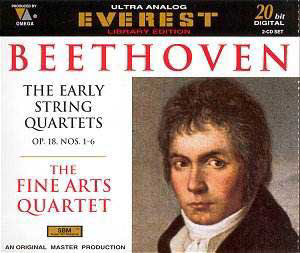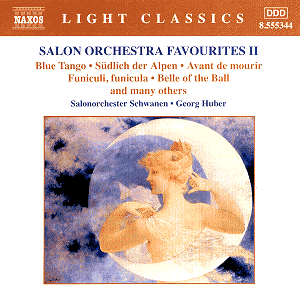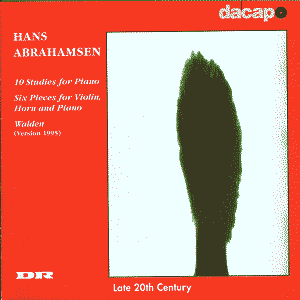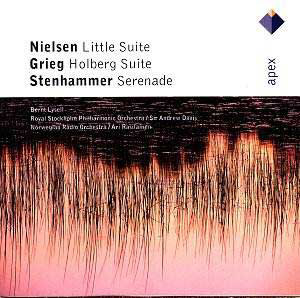 Composer: Ludwig van Beethoven
Composer: Ludwig van Beethoven
Works: The Early String Quartets Op. 18 Nos. 1-6; The Middle String Quartets Op. 59 Nos. 1-3, Op. 74, Op. 95; The Late String Quartets Op. 127, Op. 130, Op. 131, Op. 132, Op. 135, Grosse Fuge Op. 133
Performers: The Fine Arts Quartet
Recording: Recorded 1969
Label: Everest
Ludwig van Beethoven’s string quartets, an essential component of the chamber music repertoire, chart the evolution of the composer’s musical language from the Classical to the Romantic era. The Fine Arts Quartet’s 1969 recording of the complete quartets offers a fascinating window into Beethoven’s compositional journey, particularly as it captures the ensemble during a transitional period in their own history. This set stands as a testament to Beethoven’s profound exploration of form and emotional depth, as well as to the Fine Arts Quartet’s dedication to both traditional and contemporary repertoires.
The early quartets, Op. 18, reveal Beethoven’s intricate counterpoint and melodic invention, and the Fine Arts Quartet navigates these works with commendable sensitivity. In No. 1, the Adagio is marked by lyrical phrasing and a careful balance between expressiveness and restraint, avoiding excessive sentimentality—a hallmark of Beethoven’s early style. The lively concluding Allegro maintains a spirited precision that reflects the ensemble’s disciplined playing. In contrast, the G Major Quartet, No. 2, shines with its rustic charm, particularly in the Scherzo, where the quartet’s deft articulation captures the light-heartedness inherent in the music. The ensemble’s ability to blend tonal qualities across the instruments becomes particularly evident in the slow movement, where they evoke a hymn-like simplicity that is both serene and poignant.
Transitioning to the middle quartets, the Fine Arts Quartet employs clarity and a flowing tempo that enhances the structural coherence of the works. In Op. 59 No. 1, the first movement unfolds with a sense of command, allowing the music’s ebb and flow to emerge organically. The playful exchanges in the second movement contrast beautifully with the lyrical depth of the Adagio molto e mesto, wherein the musicians’ long-term structural vision links thematic material with a grace that is often overlooked by other interpretations. Their approach to Op. 74, the Harp Quartet, is marked by a fleetness, particularly in the third movement, where the lightness of touch allows the music to sparkle with joy, demonstrating their technical finesse.
As the recording progresses into Beethoven’s late quartets, the Fine Arts Quartet confronts the formidable challenge of these masterpieces with a blend of insight and restraint. The opening of Op. 127 is notable for its clear-eyed playing, opting for a slower tempo that enhances the movement’s introspective qualities. This decision allows for an exploration of the intricate textures in the first and second violin lines, demonstrating the quartet’s commitment to nuance over mere speed. The slow movement’s gradual unfolding is particularly noteworthy, as it emphasizes the emotional weight of the music without veering into excessive dramatization. The Grosse Fuge, positioned at the end of the final disc, is executed with a remarkable balance between objectivity and expression, showcasing the quartet’s ability to navigate the work’s complexity without succumbing to its intensity.
Recording quality is a crucial aspect of this reissue, utilizing 20-bit digital sound to present the Fine Arts Quartet’s tonal clarity and blend with commendable fidelity. While the acoustic may not boast the opulence found in some modern recordings, the ensemble’s lean sound offers a refreshing perspective. Their reluctance to indulge in extremes—whether in dynamics or emotional expression—might leave some listeners wanting for the fiery interpretation typical of other renowned quartets. Yet, this very equanimity allows for a different kind of appreciation, one rooted in the purity and clarity of their execution.
The Fine Arts Quartet’s contribution to the Beethoven string quartet discography deserves recognition for its thoughtful interpretations and technical prowess. Their performances may lack the bombastic extremes sometimes favored by other quartets, yet they offer a nourishing experience, characterized by a cool and crisp clarity. This recording reaffirms the Fine Arts’ place in the chamber music canon, providing listeners with a deeply satisfying exploration of Beethoven’s quartets that is both intellectually and emotionally rewarding.



